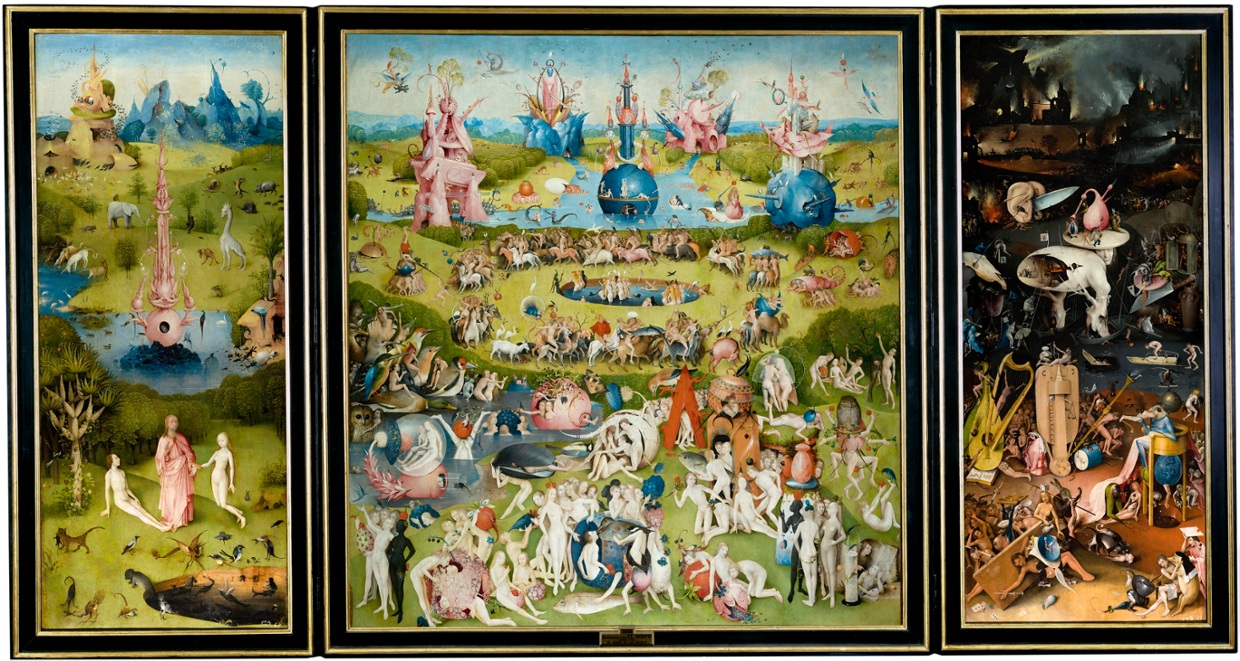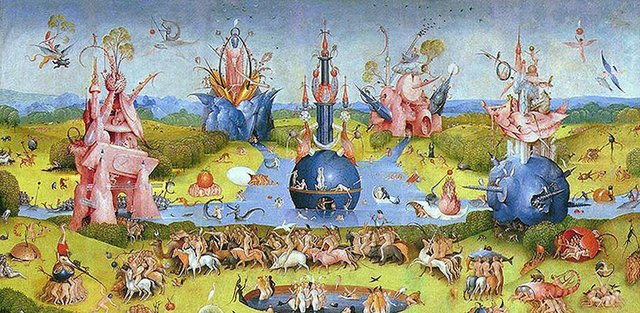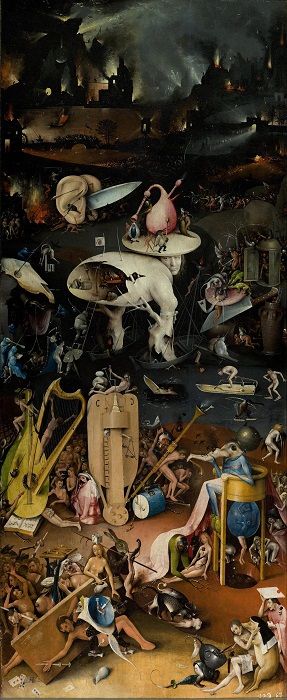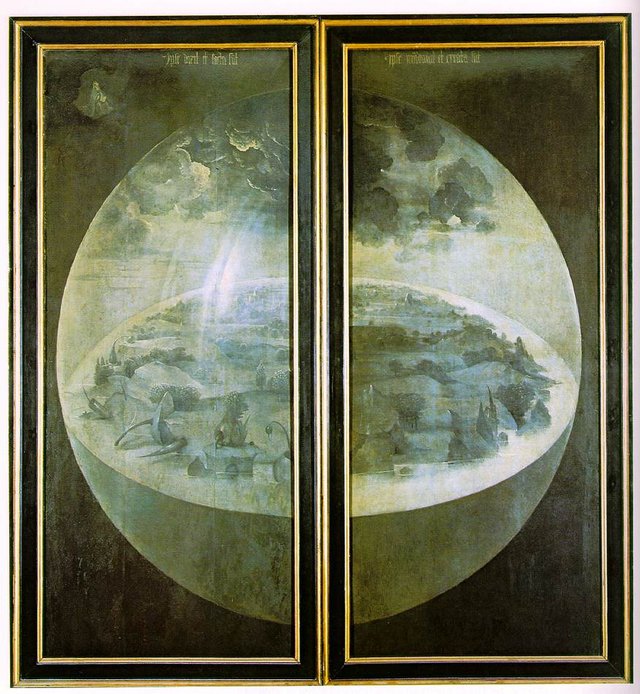Heronimus Bosch: In the world of the demonic. A Trip to the Triptych "The Garden of Earthly Delights"
The works of Bosch abound the demons, the half-horn, the half-life, and the machines. Another feature of his work is that it is subject to a strict symbolism. Its alchemical symbols include glass flasks and orbs. Another set of symbols include "sweet fruits": sour cherries, grapes, strawberries, apples, plums. Among the sex symbols, the horn, the arrow / males /, as well as the circle, the basket, the bladder / the female / are known. Some animals, the frog, for example, symbolize the devil and death, and the owl - the treachery.
Attempts of modern professionals to define somehow Bosch and his work are not entirely unambiguous. Some consider it a harbinger of surrealism, extracting "automatically" the phantasmagoric images from the depths of the subconscious. It is no coincidence that Salvador Dali and A. Bretton declare his heirs. Others believe his art reflects alchemy, astrology and black magic. Others try to motivate his work through various religious sects.
As if unifying the above, I believe that the key to Bosch's work is above all demonic. Undoubtedly, the term "demonic" "is derived from the word" demon "" which, by some strange irony, translates "god" ". Here I immediately remembered Heraclitus, who shared with his disciples, pointing the cave: "There are also demons living here (, "Even more interestingly, in ancient Greek mythology the demon can possess both positive and negative qualities. Here, a very significant characteristic of the demon (demonic) - his duality, his "arbitrariness" is already highlighted. In this direction, the interpretation of the demonic in the apocryphal literature moves, where the demon is presented as an angel driven out of the sky. The Christian tradition, however, is categorical: the demon is only a rage, an evil spirit. In the late European Middle Ages, the demon is identified with the witches.
As can be seen, ancient Greek mythology and apocryphal literature portray us the complex dual nature of the demonic, represented as a negative metamorphosis, as a decade in the direction of the divinely elevated to the depraved disgrace. In my humble opinion, this dual, open, "productive" structure of the demonic footsteps as a foundation in Bosch's work, thus motivating the complexity of its interpretation. I would be able to demonstrate this most clearly with the artist's most famous triptych: "The Garden of Earthly Delights ."

The Garden of Earthly Delights
The common name of the left part of the Triptych is Paradise. The left panel is made up of three parts: Heaven, Divine origin, Paradise / The Garden of Eden/. In Heaven - This part can be divided into two: the divine beginning and the material world. They symbolize the dualism of the world. The birds, curving in a complex way through different apertures, symbolize the divine beginning that penetrates everywhere. Birds are of different species. The mountains in blue symbolize the material beginning. The blue mountains are three and each has its own specificity. The first blue mountain (closest to the divine mountain) is the abode of the archangels. Here the birds are golden, and the mountain is decorated with shimmering white pearls. The pink fountain is a symbol of the divine beginning. This is the central element in Paradise: the divine power that gives life. The base on which the fountain is placed resembles a stony island filled with precious stones. The stony foundation symbolizes stability, reliability. Precious sparkling stones symbolize significance, exclusivity. The blue color of the water and base contrasts with the pink fountain: Bosch presents the indissoluble connection between divine and earthly.
At the base of the fountain there is an owl. It symbolizes the wisdom that will help the man to understand the upper levels of the fountain structure. The image of the owl will reappear in the central part of the triptych, but already as lying-wisdom.

Central Triptych: The Garden of Earth Pleasures
This part of the Triptych, like Paradise, must be read from top to bottom. It is divided into three levels: the divine birth of the earth, the circle of earthly life and the pleasures of earthly life.
The top of the Garden - this is the kingdom of the angels. The central tower represents earthly life. The tower is surrounded by different forces that fight each other to influence the soul of man. The middle part is a circle of earthly life. In the center is a lake - a symbol of the inner, spiritual essence of man. The lower part of the Garden depicts the sensual, external, material aspect of human life. The body begins to predominate, people are naked. Their slow down here is mostly entertainment of the flesh. In the Garden of Earth Pleasures, entertainment is not related to objects / material objects created by man.
Since there are no man-made objects in the central part of the triptyp, it is probably not the proper name of Garden of Earth Pleasures. These pleasures are related to the creation of God, not to earthly, material goodies. The third part of the Triptych, known under the name of Hell, presents man's inventions. Following this logic, it may be more appropriate for the third panel to be called Earth World or Earth Hell. It is in the third part of the triptus that people's pleasures are related to a material world created by man.
The middle part of the Triptych, called by art historians The garden of earthly pleasures, is an allegory. But not to the earthly pleasures, but to the struggle between good and evil that fought for the human soul.
In the upper part of the Garden are presented red and blue fruits, which symbolize the temptation of man: the red color symbolizes the spiritual temptations, the blue fruit - the material temptations. Interpretation of the middle panel is related to its placement and the main message of the triptych - what we see can not be anything but a seeming, fake paradise that logically ends in the right panel called "Hell".

The right Triptych - Hell
Although the contemporary interpretation of this work has raised more questions than answers, the predominant interpretation is that the Garden illustrates the idea of how temptation and sin lead to Hell. The right wing represents hell. People are subjected to various nightmare tortures, eaten by giant birds and harassed. Each of the seven mortal sins also appears.
In the foreground, a rabbit pulls its prey, attached to the legs, leaking from the stomach and blood - this is one of Bosch's favorite motifs, but here the blood from the belly is not just flowing, it springs as if it were a gunpowder. The victim becomes a hangman, the loot a hunter, and so it is best to surrender the chaos that reigns in Hell, where the normal interconnections are overturned. The world's most common, harmless, everyday objects grow up to monstrous sizes, turning into giant cannons of evil. They can be compared with giant strawberries and birds from the central part of the triptych.
On a medium-frozen lake, one more sinner balances herself on a huge skate, but she carries it forward, where another sinner is already sinking in the ice water. These images are inspired by the ancient Dutch proverb, the meaning of which resembles our importance of "balancing on thin ice".
On the right, Satan is depicted as a huge bird sitting on a chair that ate people. This is a strange creature with a bird's head and stomach from a large translucent balloon. It swallows sinners and then their bodies descend into a perfectly carved circular pit. Here is also a miser, condemned to releasing his stomach forever, his stools being made of gold coins / punishment for the greedy / and another, eternally and without rest, vomits the sweets that he has consumed / it is the sin of self-sacrifice. The motif of a demon or devil sitting on a high chair is borrowed from the text "The Tundal View".
In the lower right corner, at the foot of Satan's throne next to the hellfire, a naked woman with a frog on her chest is wrapped in the arms of a black demon with donkey ears. The woman's face reflects in a mirror (also represented as a monster) attached to the back of another, green demon. Such is the vengeance for those who succumb to the sins of the proud and the vain.
the face on which a pink bagpipes tray is placed is Bosch's self-portrait.
As you can see, here the innocent paradise (on the left) coexists with "musical" hell / right /. In the middle is the lust. Here, Bosch successfully reproduces hell as a result of a negative movement from the innocent paradise to the lust, shaping the dual structure of the demonic. What is more, in the innocent paradise, it hints at some innocent, disturbing things: for example, a leopard holds a mouse in his mouth, a bird eats a frog, etc. In other words, here in paradise, the demonic, though slightly hinted at, is present. The power of the demon is even more clearly represented by the exterior of the Triptych, depicting the Creation of the World:

Creation of the World
The outer wings depict the creation of the earth by God. God (pictured in the upper left corner of the picture) holds a book in his hand. The creature's land also unfolds such a book (the wings open on two sides, like book covers). Bosch depicts the words of the Holy Gospel of John: In the beginning was the Word; and the Word was with God; and the Word was God.
Bosch suggests: the contents of this triptych must be read. In order to read a book, the reader must know the rules under which this book was created. For example: In what direction does the text go (left-to-right, right-left, top-down, diagonal, etc.). Or, what is the meaning of the individual signs / letters (without this knowledge, he can not comprehend the text presented to him). Similarly, we must address this picture of Bosch: it contains signs that make sense. Proper reading means proper understanding of the overall concept.Here, the demonic already acquires a biathing, ontological meaning, as a dualistic interpretation of the world as a whole. Bosch's creativity ratings for himself are contradictory. Some call it a heretic, others as a "painter of the unconscious", "third" for a person with a sick consciousness. For me personally, the artist's merits are in several directions. In the first place, for the first time Bosch presents us horror as a sexual-religious-occult-mystical symbiosis. On the other hand, aesthetically speaking, through the flexible structure of the demonic depicted, he manages to "stir" "otherwise static," spatial "(according to Hegel's aesthetics). Third, through his works, he searches for ontological projection, giving the philosophical character of his work as a whole. And last but not least: By depicting the divinization of the divine towards the demonic, Bosch actually reveals the "slippery" of Good and Evil. In this line of thought, his unique creativity sounds to me like a serious warning: and in this I see his deep humanism.
Awesome choice for post!
Thanks, @cocacho.
img credz: pixabay.com
Nice, you got a 2.3% @minnowbooster upgoat, thanks to @godflesh
Want a boost? Minnowbooster's got your back!
The @OriginalWorks bot has determined this post by @godflesh to be original material and upvoted it!
To call @OriginalWorks, simply reply to any post with @originalworks or !originalworks in your message!
To enter this post into the daily RESTEEM contest, upvote this comment! The user with the most upvotes on their @OriginalWorks comment will win!
For more information, Click Here!
Special thanks to @reggaemuffin for being a supporter! Vote him as a witness to help make Steemit a better place!
fascinating thoughtful analysis, thanks
Thank you :)
Thank you @godflesh, i appreciate it!
This post received a 98% upvote from @morwhale team thanks to @godflesh! For more information, click here! , TeamMorocco! . this is @originalworks . steem @steemprice BTC
$4763.34 USD/BTCVolume: 66200.44 BTC ($315334874.27 USD)Last Updated Tue Oct 10 22:52:07 2017